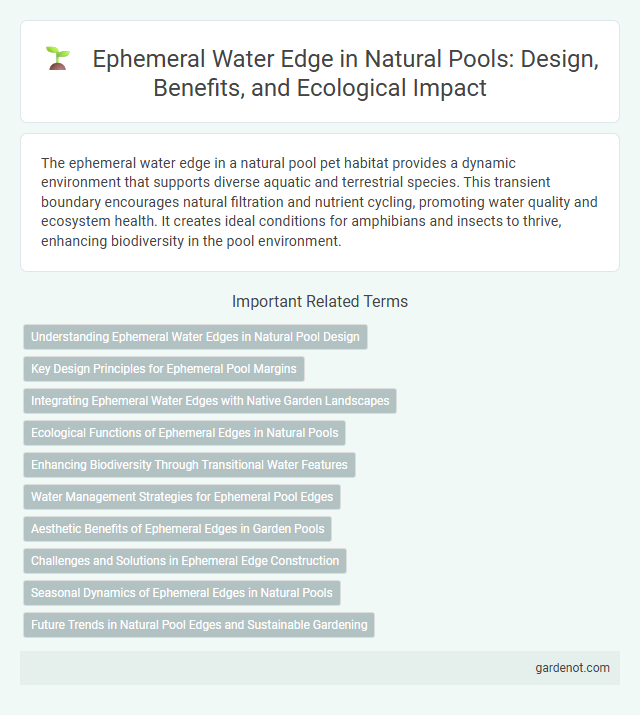The ephemeral water edge in a natural pool pet habitat provides a dynamic environment that supports diverse aquatic and terrestrial species. This transient boundary encourages natural filtration and nutrient cycling, promoting water quality and ecosystem health. It creates ideal conditions for amphibians and insects to thrive, enhancing biodiversity in the pool environment.
Understanding Ephemeral Water Edges in Natural Pool Design
Ephemeral water edges in natural pool design refer to fluctuating shorelines that appear only during specific periods of water presence, enhancing biodiversity by providing diverse habitats for aquatic and terrestrial species. These transient margins support dynamic ecological processes, such as nutrient cycling and seed dispersal, crucial for maintaining the natural balance within the pool environment. Incorporating ephemeral water edges optimizes habitat complexity and promotes sustainable water management by mimicking natural hydrological patterns.
Key Design Principles for Ephemeral Pool Margins
Ephemeral water edges in natural pools rely on key design principles such as gradual slope gradients, native vegetation selection, and dynamic water level accommodation to enhance ecological function and aesthetic appeal. Incorporating porous substrates and contour variations supports diverse microhabitats and natural filtration processes. Effective integration of these elements ensures resilience to fluctuating water presence while promoting biodiversity and water quality.
Integrating Ephemeral Water Edges with Native Garden Landscapes
Ephemeral water edges enhance natural pool ecosystems by providing seasonal habitats that support native plant diversity and local wildlife. Integrating these transient water zones with native garden landscapes promotes ecological balance by mimicking natural hydrological cycles and encouraging pollinator activity. Utilizing native grasses, sedges, and moisture-tolerant plants at the water's edge stabilizes soil while creating dynamic, sustainable garden environments.
Ecological Functions of Ephemeral Edges in Natural Pools
Ephemeral water edges in natural pools provide critical ecological functions by supporting a diverse range of amphibians, insects, and microorganisms that rely on temporary aquatic habitats for breeding and development. These transient zones facilitate nutrient cycling and sediment filtration, enhancing water quality and promoting habitat heterogeneity essential for biodiversity. By fostering dynamic interactions between aquatic and terrestrial ecosystems, ephemeral edges contribute significantly to the resilience and ecological balance of natural pool environments.
Enhancing Biodiversity Through Transitional Water Features
Ephemeral water edges create dynamic habitats that support diverse plant and animal species by providing periodic moisture and varied microenvironments. These transitional water features foster ecological niches essential for amphibians, insects, and migratory birds, enhancing overall biodiversity within natural pools. Integrating ephemeral zones into natural pool designs encourages resilient ecosystems by mimicking natural hydrological cycles and promoting species propagation.
Water Management Strategies for Ephemeral Pool Edges
Water management strategies for ephemeral pool edges prioritize maintaining natural hydrological cycles by allowing periodic drying and refilling, which supports diverse aquatic and terrestrial species. Techniques such as creating buffer zones with native vegetation minimize erosion and filter runoff, enhancing water quality and habitat stability. Implementing controlled water retention structures can regulate water levels without disrupting the dynamic ephemeral edge, ensuring ecological balance and resilience.
Aesthetic Benefits of Ephemeral Edges in Garden Pools
Ephemeral water edges in garden pools create dynamic visual interest by fluctuating water levels that reveal intricate textures and natural materials along the shoreline. This constantly changing boundary fosters a seamless integration between aquatic and terrestrial environments, enhancing biodiversity and inviting seasonal reflections that enrich the sensory experience. The aesthetic allure of these transient margins adds depth and movement, transforming a static garden pool into a living, evolving landscape feature.
Challenges and Solutions in Ephemeral Edge Construction
Ephemeral water edges present challenges such as fluctuating water levels, soil erosion, and difficulty in stabilizing native vegetation. Effective solutions include using permeable materials to enhance water infiltration, implementing native plant species with deep root systems to anchor the soil, and designing flexible edge contours that accommodate changing water dynamics. Incorporating bioengineering techniques like coir logs and live staking further improves resilience and ecological function in natural pool ephemeral edges.
Seasonal Dynamics of Ephemeral Edges in Natural Pools
Ephemeral water edges in natural pools exhibit dynamic seasonal fluctuations influenced by precipitation patterns and temperature variations. These transient margins provide critical habitats for diverse aquatic and terrestrial species during wet phases, while their periodic drying supports nutrient cycling and soil aeration. Understanding the seasonal dynamics of ephemeral edges enhances conservation efforts by highlighting the importance of temporal habitat variability in maintaining ecosystem resilience.
Future Trends in Natural Pool Edges and Sustainable Gardening
Future trends in natural pool edges emphasize the integration of ephemeral water edges that mimic natural wetland ecosystems, enhancing biodiversity and water purification. These designs incorporate native aquatic plants and adaptive substrates to create dynamic, self-sustaining margins that support sustainable gardening practices. Innovations in eco-friendly materials and automated water level management systems further promote conservation and resilience in natural pool landscaping.
Ephemeral water edge Infographic

 gardenot.com
gardenot.com